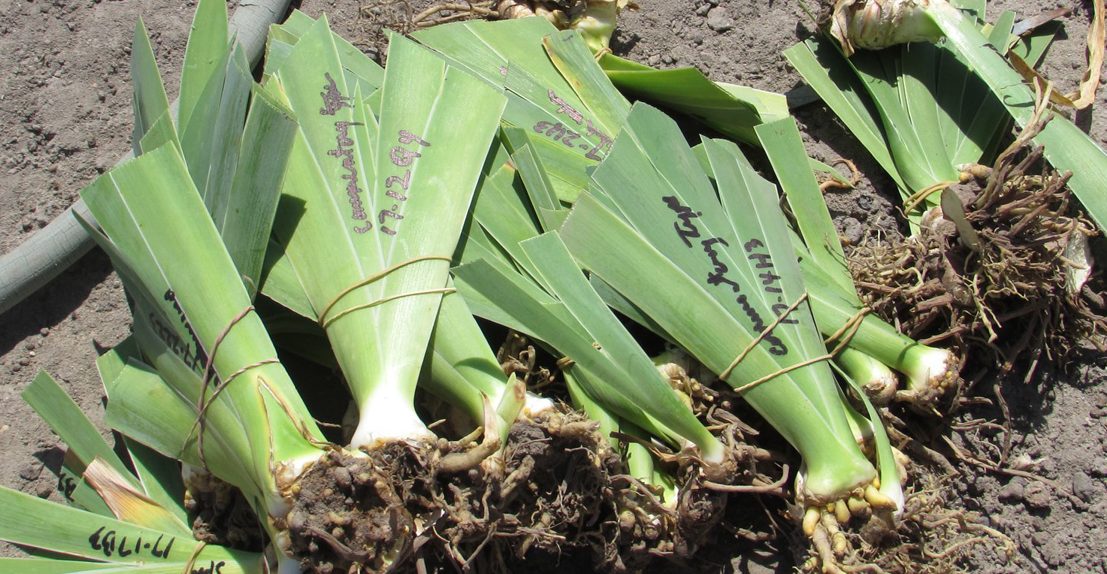Growing Tall Bearded Iris
Tall Bearded (TB) irises are among the easiest of garden plants to grow, and will give good results with minimal care. The better the culture, however, the more magnificent the display.
Plant Habit
Perennials forming clumps of sword-like leaves, 2 feet high and 2-3 feet around. Flower stalks display 6 to14 blooms above the foliage in the spring. In our area, some varieties bloom again in autumn or winter. Flowers are 6 inches tall, large and showy, with six petals. Three upright petals are called “standards” and the three pendant or semi-flaring petals are called “falls”.
Location
Select a site that receives at least six hours of sun a day and where the soil is well drained. TB irises may survive, but not bloom, if grown in too much shade. Also, be careful that neighboring plants or weeds don’t grow across the top of the rhizome. Sunlight and air circulation right down to the rhizome will give the best results.
Water
Water any time the soil has dried out to a depth of about two inches, and give the plants a good soaking. Re-bloomers need water during summer to produce the fall bloom. When transplanting, you must keep the soil moist until the plants have established new roots, about four weeks, or until there are four new leaves growing. Irises are well suited for drip systems. Too much water is more likely a problem than too little.
Soil
Tall bearded Irises like a well-drained soil that is slightly alkaline and high in calcium. Organic matter is helpful. Iris benefit from the addition of compost, but be sure to delay planting for at least two weeks after working the compost into the soil, because too much nitrogen can promote rot. Perlite or vermiculite added to a sandy soil will promote water retention. Agricultural gypsum, if the soil is alkaline, or agricultural lime, if the soil is acid, can be used to loosen clay soils, and provide calcium.
Fertilizer
Use a balanced fertilizer, (for example 10-10-10, 15-15-15) in early February, again in mid March and again in summer. The summer application is especially good for re-bloomers or to keep good-looking plants in the garden. High nitrogen content promotes too lush growth that is more susceptible to bacterial soft rot during warm weather. Higher phosphorus can promote strong roots, solid rhizomes and strong and plentiful bloom stalks.
Transplanting
Best results are from July through mid September. Any later transplanting may cut down on the chances for next year bloom, but the plant will probably survive. Bone meal is high in calcium and phosphorus, and a handful per plant really helps to grow strong stems and plentiful flowers. Plant the rhizomes with the top just below the surface of the soil. If you are dividing old clumps, or planting new plants, select rhizomes with a good fan of leaves and evidence of new increase (pointed buds on the sides of the rhizome).
Label named varieties with a permanent marker on the fan if you are digging your own iris. A map is the most reliable of keeping track of your colors. A Brother label maker, pencil or permanent marker can be used to mark cut up Venetian blinds to keep track of new varieties, but markers tend to fade and get moved during the year. A $30 label maker looks much more professional and the name is visible form a distance for spring shows, but permanent marker and stick on labels tend to fade within a year. Label and map your iris soon after transplanting because irises look bewilderingly similar after blooming.
Space the rhizomes two to three feet apart if you wish to leave the plants undisturbed for several years. For an instant clump effect, space the rhizomes eight inches apart in triangles of three, with the fans (“heel” of the rhizome) facing outward and the back (“toe” end of the rhizome) pointed to the middle of the triangle. After planting, soak the ground and then allow the soil around the top of the rhizome to just become dry before watering again (soil at the bottom of the rhizome may still be slightly damp). Divide every two to four years to avoid overcrowding.
Diseases
Groom plants several times a year: cut and remove (do not compost) brown, spotted and damaged leaves. You may spray leaves to eliminate aphids—use amounts recommended for ornamentals. Primary pests are slugs and snails—use liquid or pellet baits. Gophers eat tall bearded irises, but deer do not. Beware of rhizomes that show evidence of disease or that are mushy at the base of the fan where the leaves join the rhizome. Straight Ajax powder (or 1 part bleach to 8 parts water) applied to diseased areas can sometimes save the rhizome. Most diseases can be avoided by sanitizing new rhizomes as you bring them into the garden. Immerse for 20 minutes in a solution of one part chlorine bleach to eight parts cool water. Remove from bleach and allow to dry. Plant the rhizome within 24 hours.
